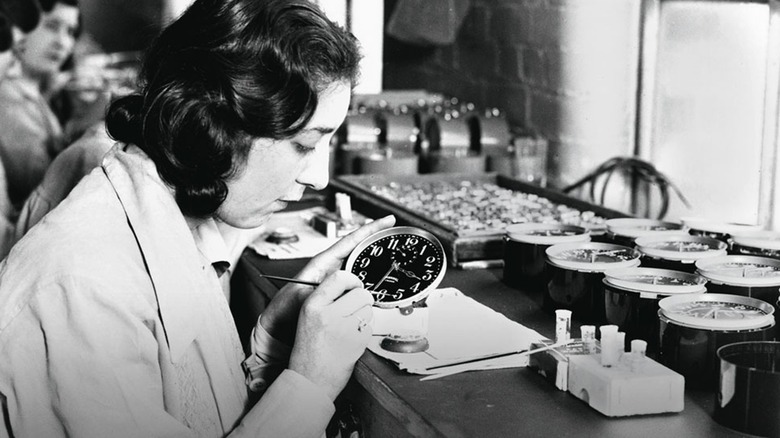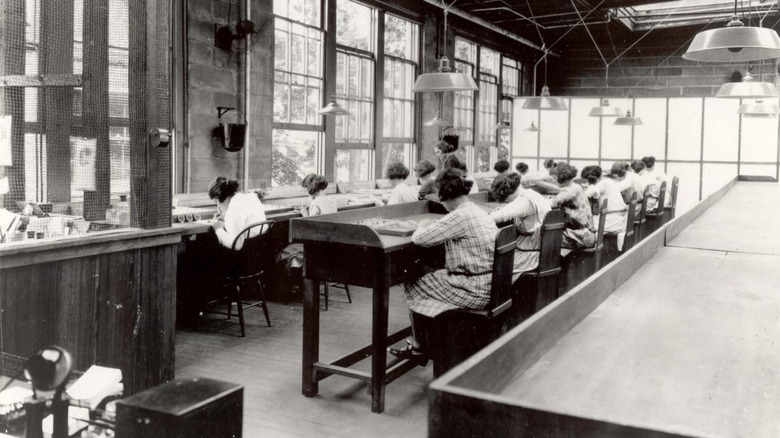What Happened To The Bodies Of The Radium Girls?
By now, modern industry has done a decent job vetting hazardous elements we could come into contact with — albeit often accidentally. Lead was slowly removed from paint starting in 1960, although it still exists in certain paints today. We all know that handling mercury with our bare hands is a dumb idea, although some cosmetic products still contain it. In the late 1800s arsenic pills hit the market as a way to beautify skin, only to cause arsenic poisoning.
Radium is another lesser-known example of a toxic metal that once made its way into household goods. In the early 1900s businesses cropped up across the United States that used radium paint. The chemical element glows in the dark, the kind of nifty gimmick that still catches people's attention nowadays. It's also naturally radioactive and sheds alpha particles, a byproduct of some radioactive elements. In fact, it's so radioactive that it's modernly used to treat some types of cancer that's spread to bones. One-hundred or so years ago, though, radium's toxicity wasn't well-understood.
Back then, "radium girl" factory workers applied radium-infused paint to clock and watch faces. They used their lips to make the tips of their paint brushes fine enough to apply detailed paintwork, aka "lip-pointing." Over time, these women suffered a host of horrific diseases, even having chunks of their jaws fall out. Ultimately, these women died one by one. Most were buried, but at least two — Peg Looney and Mollie Maggia — were exhumed for research purposes.
[Featured image by Esther Mateo and Kate Moore via Wikimedia Commons | Cropped and scaled | CC BY-SA 4.0]
Poisoned and buried
Radium must have seemed like a miracle product. "Made possible by the magic of radium!" product labels read, per NPR. Its glow was its allure. Aside from appearing on clock and watch faces it was touted as an aphrodisiac, beautifier, and even medicine. By the time radium girls started dying, manufacturers were in too deep and didn't want to lose money. Even as the women succumbed to poisoning manufacturers denied there were any problems.
Mollie Maggia was the first radium girl to die at the age of 24 in 1922. Her mouth wouldn't stop bleeding. Her breath turned rank, and her jaw started to rot — eventually it had to be removed. Other radium girls across the U.S. suffered similar fates, including bone decay, cancer, joint problems, hemorrhaging, pregnancy issues, and much more. By 1927, over 50 such women had died.
These women were employed by several radium-based companies, including the U.S. Radium Corporation and Radium Dial Company. But because they worked at a variety of factories across the United States, such as in Ottawa, Illinois and Waterbury, Connecticut, they were buried in various cemeteries across the country. Not all of their grave locations are known, but Find a Grave has a list of 19 burial sites across 11 cemeteries in New Jersey, Illinois, and Connecticut.
[Featured image by Unknown author via Wikimedia Commons | Cropped and scaled]
Concerns about radioactivity
French physicist Marie Curie discovered the existence of radium and its radioactive properties in 1898, a couple of decades before the radium girls started getting sick and dying. Folks knew that lead blocked radiation, and we know that at least one radium girl — Peg Looney — was buried in a lead coffin in 1929. There's no information about the types of coffins in which the other radium girls were buried.
Looney, like the first radium girl to die — Mollie Maggia — was later exhumed for research purposes. As Popular Science says, doctors found that, "Each and every portion of tissue and bone tested gave evidence of radioactivity." Maggia was later returned to her resting place in Rosedale Cemetery in Orange, New Jersey, where her two sisters and fellow radium girls Quinta and Albina were also buried.
On Roadtrippers, an intrepid visitor to the Maggia sisters' graves reports carrying a Geiger counter to test radiation levels in the areas where the sisters were buried. The writer reported no increases in radiation from nominal, typically ambient levels. According to the Royal Society of Chemistry, some radium isotopes decay in as little as about three-and-a-half days. Radium-226, however — the isotope used to paint clocks and watches 100 years ago — has a half-life of 1,599 years. But its alpha particles can only travel about an inch, per the Washington Department of Health, which explains why a Geiger counter wouldn't detect any radiation above a radium girl's grave.


